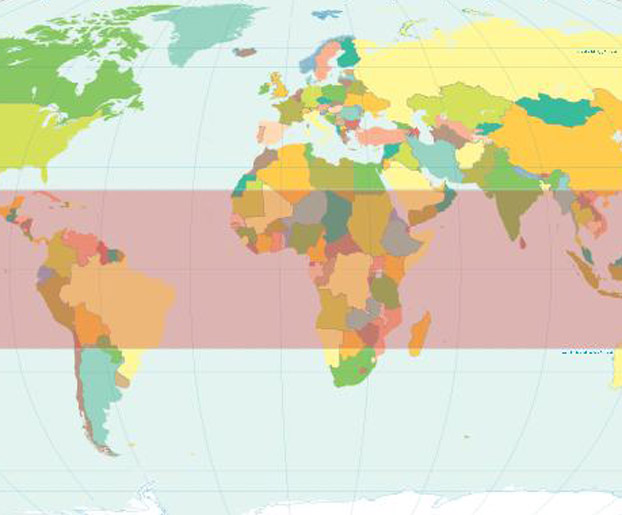Pollutants Mucking With Food Production

Two manmade pollutants known best as threats to human health have just been charged with two more offenses: shifting rainfall patterns and mucking with food production.
ANALYSIS: U.S. Pollution: Made in China
Black carbon and tropospheric ozone, both of which derive from the incomplete burning of fossil fuels, may be working in cahoots with greenhouse gases to expand Earth’s tropical belt (highlighted above in red).
Unabated, future expansion could drive major shifts in global precipitation patterns, which could in turn disrupt regional agriculture, warns climatologist Robert J. Allen of the University of California, Riverside.
When the tropics widen, wind patterns shift toward the poles, dragging important mid-latitude storm tracks along with them. If storm systems move farther north, for example, southern portions of the U.S. and Asia could become drier, Allen explained in an article published in UCR Today.
Based on comprehensive new climate simulations, Allen and his colleagues reported in Nature that black carbon and tropospheric ozone are the most likely primary drivers of the tropical expansion observed in the Northern Hemisphere. (In the Southern Hemisphere, the main culprit is depletion of stratospheric ozone.)
ANALYSIS: Ozone Hole a Surprise Rainmaker
Direct observations have shown that the tropics widened by 0.7 degrees latitude per decade between 1979 and 2009, and previous climate simulations revealed that heating of the atmosphere at mid-latitudes is to blame. As expected, warming from greenhouse gases contributed to this effect. But Allen and his colleagues discovered that simulations that ignored black carbon and tropospheric ozone underestimated the observed tropical expansion in the Northern Hemisphere by about a third.
When they included black carbon and tropospheric ozone in the mix, their simulations showed far better agreement with observations. Indeed, their results imply that these two pollutants are responsible for about 70 percent of the recent tropical expansion in the Northern Hemisphere, Allen told Discovery News.
That's no surprise when you consider that black carbon and tropospheric ozone both absorb solar radiation. And since they persist in the atmosphere only one or two weeks, they cause the greatest atmospheric heat gain near their sources, which in the Northern Hemisphere tend to be the heavily populated low- to mid-latitudes.
“Greenhouse gases do contribute to the tropical expansion in the Northern Hemisphere,” Allen said. “But our work shows that black carbon and tropospheric ozone are the main drivers here. We need to implement more stringent policies to curtail their emissions, which would not only help mitigate global warming and improve human health, but could also lessen the regional impacts of changes in large-scale atmospheric circulation.”
PHOTOS: Facts and Fables About Eco-Labels
Image: Courtesy Robert J. Allen / UC Riverside
Copyright © 2012 Discovery Communications, LLC. The number-one nonfiction media company.